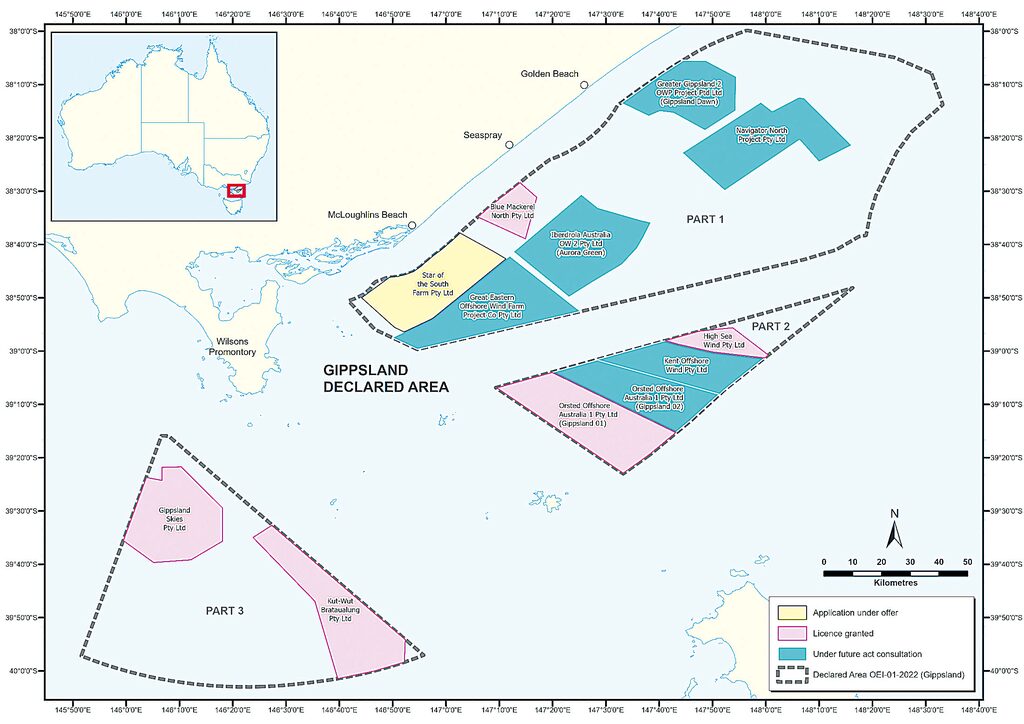By ERIKA ALLEN and STEFAN BRADLEY
AUSTRALIA’S offshore wind ambitions have advanced significantly after the federal government announced last week that the first six proponents have been granted feasibility licences within the Gippsland zone, with another six pending.
The federal government says the 12 projects could generate enough electricity to power the Gippsland region’s annual industrial consumption 100 times over.
The estimated 25GW is more electricity than the entire state generated last year.
Wellington Shire is set to be the hub of the Gippsland Zone, with areas situated off the coast of Seaspray, McLoughlins Beach and Golden Beach (as the accompanying graphic shows).
Federal Minister for Climate Change and Energy, Chris Bowen, made the announcement last Wednesday (May 1) at the Energy Users of Australia Association annual conference in Melbourne.
At this stage, High Sea Wind Project North, Gippsland Skies, Blue Mackerel North, Kut-Wut Brataualung Project, Ørsted 1 and Star of the South have been granted feasibility licences in the Gippsland offshore wind zone.
The federal government intends to grant a further six licences to Iberdrola Australia OW 2 (for its Aurora Green wind farm), Greater Gippsland 2 OWP Project (Gippsland Dawn), Navigator North Project, Ørsted Offshore Australia 1 (Gippsland 02), Kent Offshore Wind, and Great Eastern Offshore Wind Farm Project Co.
These projects are spread across a nearly 15,000 square kilometre site, stretching from Lakes Entrance to Wilsons Promontory.
From January 23 to April 27 last year, the federal government accepted feasibility licence applications for proposed projects within the declared area.
A total of 37 applications for licences were considered by the federal government, including Flotation Energy’s, Seadragon project. Flotation Energy is a Scottish company owned by Tokyo Electric Power Company offshore wind project, but the company was not granted a feasibility licence.
This rejection of the licence comes despite the state government granting Seadragon ‘Major Project Status’ last year, predicting it had a capital expenditure of $6.5 billion and would create around 1600 construction jobs and 200 ongoing jobs over 35 years.
Carolyn Sanders, Executive Director of Flotation Energy, had confirmed the news earlier this month.
“We’re obviously very surprised and disappointed. We’ve been working on Seadragon since 2019, and it’s an excellent project,” Ms Sanders said.
“The federal government thought so too. That’s why they awarded us Major Project Status last year.”
Major Project Status is federal recognition of the national significance of a large-scale (worth over $50 million) project for economic growth, employment and its need for support to navigate complex regulatory approval. However, the federal government says it does not guarantee a green light.
Shadow Minister for Energy, Energy Affordability and Security, David Davis, said earlier in the year that the decision not to grant Flotation Energy a feasibility licence would add more pressure on the state government to achieve its offshore wind energy targets.
“Why has federal minister Chris Bowen cut Flotation Energy out of the Gippsland wind region licences? What representations did the Victorian Minister for Energy, Lily D’Ambrosio, make on behalf of the company supported by a Victorian government grant?” Mr Davis said.
A spokesperson for Minister Bowen said, “The process for awarding feasibility licences in Gippsland was highly competitive, with only the most meritorious applications being taken forward”.
“Proponents who were unsuccessful in Gippsland may apply for licences in the other offshore wind zones around Australia,” they added.
Mr Bowen said the market response for the Victorian-South Australian tender process was “massively oversubscribed” and reflected a competitive market.
Bids for 19,000GW – 32 times more than the 600MW the federal government sought – were received.
“I’ve awarded feasibility licences to projects that would bring the most rewards for Gippsland, its workforce and for our energy security,” Mr Bowen said.
Mr Bowen said “merit criteria” was used to prioritise projects that enhance grid reliability, strengthen local supply chains, and promote energy system efficiency. Successful projects must benefit local industries, communities, job creation, and support for First Nations while also ensuring sustainable operation in a low-energy-price environment through the Capacity Investment Scheme.
Gippsland Skies Offshore Wind (Gippsland Skies) was granted a feasibility licence for a fixed bottom 2.5GW project located within Part 3 of Gippsland’s offshore wind zone. The developer expects the first phase to be operational by 2032. At the project’s fully operational capacity, Gippsland Skies estimates enough energy to power 1.4 million homes across the state will be produced.
Gippsland Skies is jointly owned by a group of Australian and international companies, comprising Mainstream Renewable Power (35 per cent), Reventus Power (35 per cent), AGL (20 per cent) and DIRECT Infrastructure (10 per cent).
The energy developer said the project could create 4700 direct jobs over its 40-year life span, around 2000 of which would be in the Gippsland region.
Peter Coleman, Chair of DIRECT Infrastructure, which holds a 10 per cent stake in Gippsland Skies, said, “Work is already underway to explore opportunities with local TAFE colleges and universities on workforce education, skills development and training, and to prioritise the use of local businesses”.
Overall, the federal government says the proposed projects could create more than 15,000 jobs during construction and another 7500 ongoing jobs.
“These offshore wind projects will also support thousands of jobs in Gippsland and across the supply chain – opening up new opportunities for skills development within the renewable energy industry,” state Minister for Energy and Resources, Lily D’Ambrosio said.
Ms D’Ambrosio added that projects in the Gippsland offshore wind zone will be vital in delivering the state’s renewable energy transition and meeting targets of at least 2GW of offshore wind energy generation by 2032, 4GW by 2035 and 9GW by 2040.
Mr Bowen said offshore wind is “energy-rich” and possesses a “similar capacity factor as gas and coal-fired plants”.
Markus Brokhof, AGL’s chief operating officer, said the Gippsland Skies Offshore Wind project could be an “ideal complement to the transition of AGL’s Loy Yang Power Station into the Latrobe Valley Energy Hub”.
AGL has a 20 per cent stake in Gippsland Skies Offshore Wind.
The Loy Yang Power Station generates about 30 per cent of Victoria’s energy supply. In September 2022, AGL announced its closure by June 30, 2035. The closure date was confirmed in August last year after AGL signed a structured transition agreement with the state government aimed at providing certainty to workers, the community and industry.
Addressing the Energy Users of Australia Association conference on Mr Bowen said the transition to renewable energy is driven by reality rather than ideology. The reality he described is that coal-fired power stations are “ageing and exiting”.
“The transition (to renewables) is unprecedented – but unavoidable,” he said.
“A challenge – but an opportunity.
“Difficult – but necessary.”
Environmental justice group Friends of the Earth said it welcomed the announcement, saying offshore wind will make a major contribution to action on climate change and create thousands of jobs.
“The offshore wind industry represents a much needed boost for jobs in the Gippsland region as our energy sector changes,” said Wendy Farmer, Gippsland community organiser with Friends of the Earth.
“Strong measures must be put in place to ensure offshore wind projects are not only successful but beneficial for both the environment and the local communities.”
Federal Member for Gippsland, Darren Chester, told the Gippsland Times that while he welcomes the process of developing major offshore wind projects, he is “cautiously optimistic” that some projects will proceed beyond the feasibility stage.
“While the local community is generally supportive of this fledgling industry, there is a level of concern regarding transmission towers crossing private property, the impact on commercial fishing, and the extent of measurable local benefits in terms of employment and economic activity,” Mr Chester said.
“The regions which host industrial scale renewable energy projects like this should get a guaranteed economic return, and I’ve written to the Prime Minister to suggest we need a system where a percentage of offshore wind energy revenue is given directly to the host communities, including Gippsland.”
Mr Bowen said communities will have opportunities to provide input before construction begins, such as during the development of management plans, approval processes, and the application for commercial licenses.
In his speech, Mr Bowen emphasised the importance of community feedback, saying the federal government values local input, as demonstrated by their response to community views on the zone area last year.
“I reduced the draft zone substantially following consultation, such as not declaring the area west of Wilsons Promontory,” Mr Bowen said.
On August 31, 2023, it was confirmed that the region west of Wilsons Promontory would not be considered for future offshore wind projects because of environmental concerns.
Mr Bowen noted awarding feasibility licences is not a final tick of approval.
Developers can apply for a commercial license only after demonstrating feasibility, paving the way for final approval and the commencement of offshore wind project construction for commercial electricity production.











